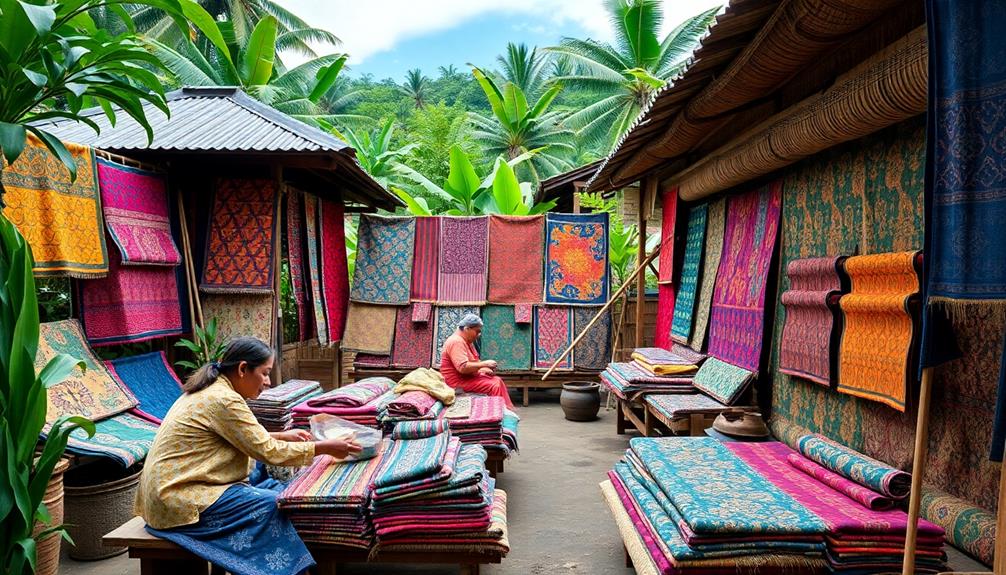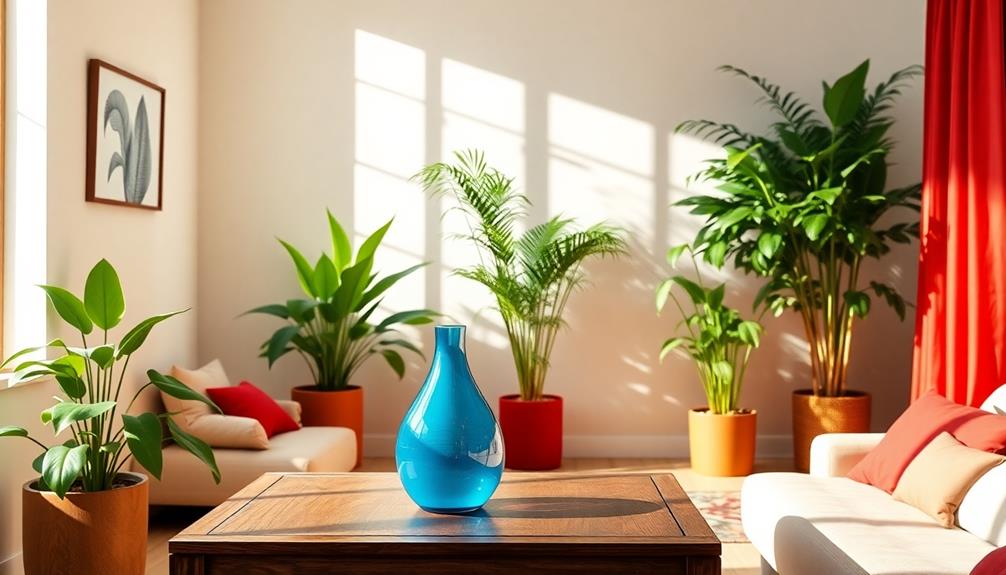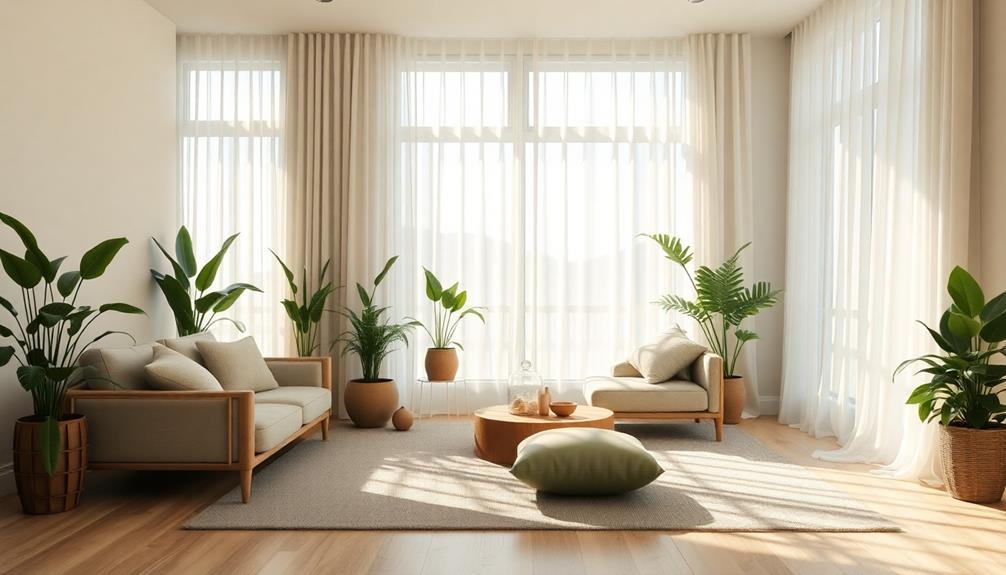Indonesian textiles, especially batik, are rich in secrets that can transform your designs. Each batik pattern carries deep cultural meanings tied to nature and social status, showcasing Indonesia's heritage. Designers often use intricate techniques like batik tulis, where patterns are hand-drawn with a canting tool, taking an entire day for just one piece. Modern mass production threatens this craftsmanship, pushing artisans to adapt their designs. However, a focus on sustainability and innovative interpretations can breathe new life into traditional textiles. If you're curious about how these elements shape the future of fashion, there's even more to explore.
Key Takeaways
- Traditional batik techniques, like Batik Tulis, require immense skill and time, making authentic pieces rare in a world of mass production.
- Many contemporary designs often lack the cultural depth and meanings embedded in traditional batik patterns, risking dilution of heritage.
- The rise of fast fashion pressures artisans to abandon traditional craftsmanship for quicker, cheaper production methods, threatening the survival of these techniques.
- Innovative designers are revitalizing batik by combining modern aesthetics with sustainable practices, ensuring cultural relevance while addressing environmental concerns.
- Social media has transformed the perception of batik, allowing for diverse interpretations but also contributing to potential misrepresentation of its cultural significance.
The Legacy of Batik
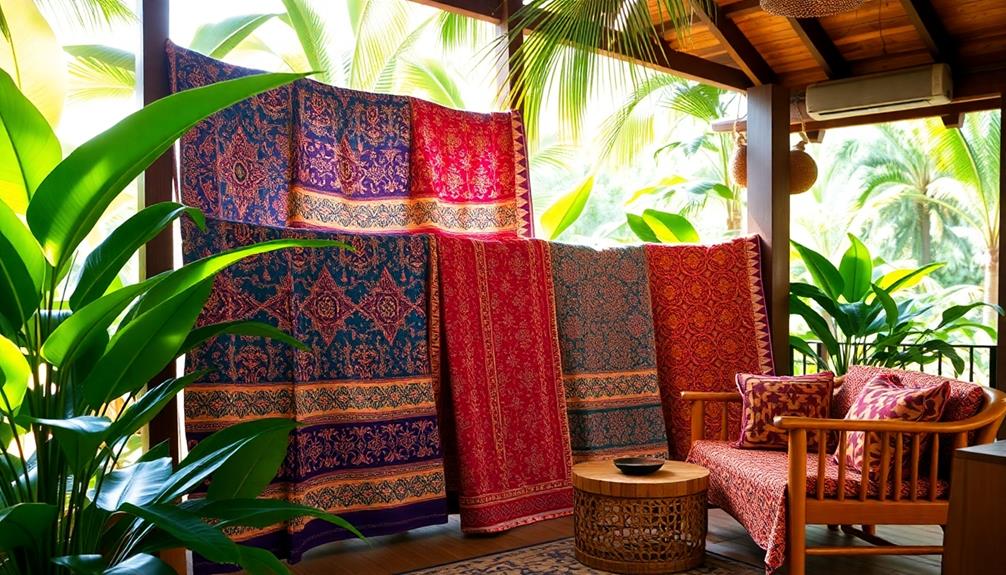
The artistry of batik embodies a rich legacy that transcends mere decoration; it's a vibrant expression of Indonesian culture. Recognized by UNESCO as a Masterpiece of the Oral and Intangible Heritage of Humanity, batik involves intricate wax-resist dyeing techniques that can take an entire day to produce a single piece.
The term "batik" stems from the Javanese word "bathikan," meaning to draw or mark, which highlights the craftsmanship and cultural significance woven into each design.
When you explore traditional Indonesian batik, you'll discover various styles such as Batik Tulis (hand-drawn), Batik Cap (stamped), and Batik Lukis (painted). Each showcases distinct techniques and artistic expressions, reflecting the rich history and diverse cultures of Indonesia.
Batik patterns often carry deep meanings tied to social status, nature, virtues, and historical events, transforming each piece into a narrative textile.
However, traditional batik faces challenges from modern printing methods that threaten its labor-intensive craftsmanship.
It's essential for you to recognize and support preservation efforts to guarantee that this extraordinary legacy continues to thrive, keeping the essence of batik alive for future generations.
Sustainable Textile Practices
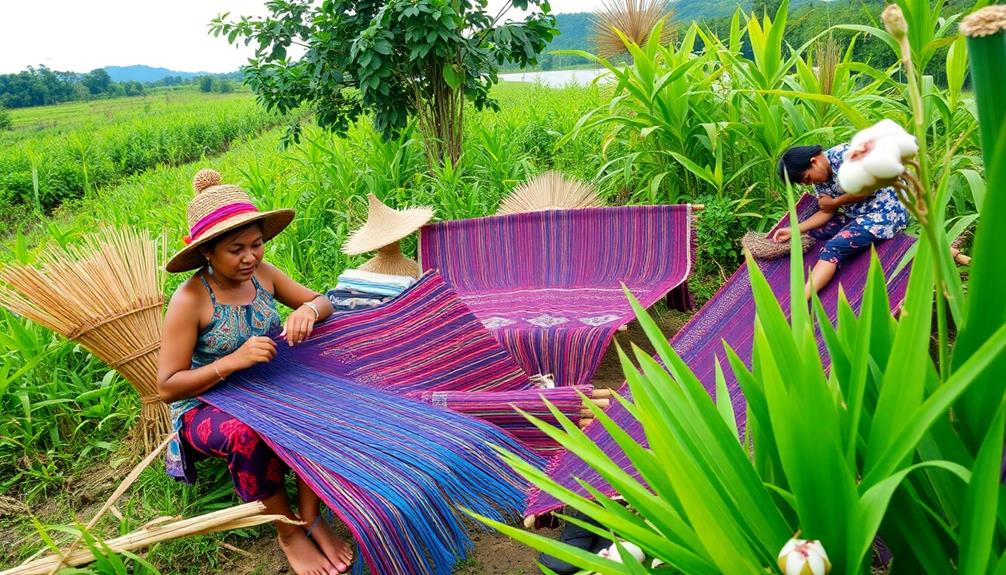
Sustainable textile practices have become essential in today's fashion landscape, reflecting a growing awareness of environmental impact. Brands like Sejauh Mata Memandang, founded by Chitra Subyakto, are leading the way by emphasizing circular fashion and waste reduction.
They focus on designing for longevity, ensuring that the items you purchase last longer and contribute to a more sustainable world. Additionally, the use of traditional Indonesian fabrics, such as vibrant Batik and Ikat textiles, not only adds unique aesthetic value but also supports sustainable practices by preserving cultural heritage.
Here are four reasons why you should embrace sustainable fashion practices:
- Protect our planet: By choosing environmentally friendly textiles, you reduce harmful waste and pollution.
- Support local artisans: When you purchase Indonesian textile products, you foster local economies and preserve traditional craftsmanship.
- Promote ethical production: Sustainable practices often mean better working conditions and fair wages for workers.
- Inspire change: Your choices can raise awareness about the importance of sustainability in fashion, encouraging others to follow suit.
In a world increasingly aware of its environmental footprint, brands like Sejauh Mata Memandang aren't just creating fashion; they're igniting a movement toward responsible consumption and eco-friendly textiles.
Cultural Significance of Batik

When you explore batik, you uncover its rich historical roots and how it's evolved over time. Each intricate pattern tells a story, symbolizing everything from social status to nature, and reflects the values of Javanese culture.
The artistry of batik is akin to the craftsmanship found in unique Indonesian decor masks, which also embody cultural narratives through their designs.
Recognized by UNESCO, batik isn't just art; it's a crucial piece of Indonesia's heritage that you can appreciate in every stitch.
Historical Roots and Evolution
Batik, with its intricate patterns and vibrant colors, has been an essential part of Indonesian culture for centuries, particularly in Java. This art form embodies the rich history and identity of the Javanese people, where traditional patterns have evolved regionally and are tied to royal lineage and cultural significance.
The beauty of batik can also be seen in its incorporation into traditional Indonesian style home decor, where it enhances the aesthetic appeal of interiors through textiles and patterns.
Here are four reasons why Indonesian batik is so important:
- Cultural Identity: Each piece tells a story, representing the unique heritage of different regions.
- Artisanal Craftsmanship: The labor-intensive wax-resist dyeing techniques, such as Batik Tulis and Batik Cap, highlight the skill and dedication of artisans.
- UNESCO Recognition: Batik is celebrated as a Masterpiece of the Oral and Intangible Heritage of Humanity, emphasizing its global significance.
- Historical Narratives: Traditional patterns often symbolize social status, virtues, and historical events, preserving the legacy of the Javanese culture.
Despite its deep roots, traditional batik faces challenges from cheaper printing methods, risking the survival of artisanal practices.
Symbolism in Patterns
Exploring the intricate patterns of batik reveals a world rich in cultural significance and symbolism. Batik patterns aren't just beautiful; they carry deep meanings tied to Indonesian culture, reflecting events, traditions, and social status. Each motif tells a story, often linked to nature or virtues, particularly in Javanese culture.
Additionally, the vibrant artistry of traditional Indonesian decor masks complements the batik, as both forms serve to celebrate and express the rich heritage of Indonesia.
As you investigate the various designs, you'll notice that every region in Indonesia boasts its distinct batik styles, showcasing local identities and historical narratives that diversify the patterns across the archipelago. For instance, specific motifs were once reserved for nobility, emphasizing the fabric's exclusivity and importance.
The process of creating batik—whether through intricate hand-drawing or stamping with wax—demonstrates the craftsmanship involved and the labor intensity that brings each piece to life. This artistry enhances the cultural value of batik, making it more than just a textile.
When you wear or admire batik, you're not just appreciating a piece of fabric; you're connecting with a rich cultural heritage that's deeply woven into the identity of Indonesia, celebrating the beautiful symbolism in patterns that tell timeless stories.
UNESCO Heritage Recognition
In 2009, UNESCO recognized batik as a Masterpiece of the Oral and Intangible Heritage of Humanity, highlighting its profound cultural significance and the exceptional craftsmanship involved.
This recognition shines a light on batik fabrics, which embody centuries of tradition and artistry.
Batik is more than just a textile; it serves as a canvas for cultural identity. Here are four emotional aspects of its significance:
- Connection to Ancestry: Each piece tells stories of your heritage, linking you to your ancestors.
- Symbolism: Batik patterns reflect virtues and historical events, making each design meaningful.
- Artisan Skill: The labor-intensive process showcases the dedication of artisans who often spend an entire day on a single piece.
- Cultural Resilience: Despite modern printing methods threatening its authenticity, the enduring spirit of batik continues to thrive.
UNESCO recognition not only affirms batik's artistic value but also emphasizes the importance of preserving this unique craft for future generations.
Embracing batik means valuing your cultural identity and the rich heritage it represents.
Techniques Behind Batik Creation
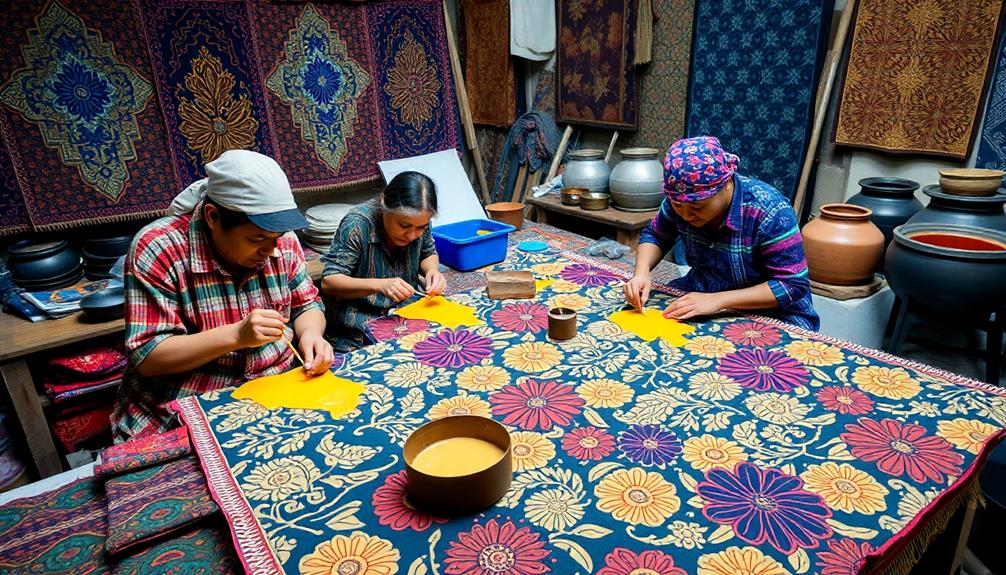
Throughout history, artisans have mastered the intricate wax-resist dyeing technique that defines batik creation. This traditional craft begins with applying hot wax to fabric, creating detailed designs that will resist dye.
You can choose to hand-draw these patterns using a canting tool in a method known as Batik Tulis, or opt for a quicker production using copper stamps, known as cap. Each piece in your batik collection can take an entire day to create, showcasing the labor-intensive nature of this textile design.
Additionally, batik often shares similarities with other Indonesian handicrafts, such as the culturally rich designs found in Indonesian decor masks, highlighting the country's diverse artistic heritage.
Batik isn't just about aesthetics; the intricate patterns often carry deep symbolic meanings. They relate to nature, social status, and cultural heritage, making each piece a unique storytelling medium.
You'll encounter various styles, such as Batik Lukis, which involves painting on undyed cloth, and Batik Pesisir, characterized by its vibrant coastal influences.
Whether you're drawn to the meticulous craftsmanship or the rich narratives woven into these fabrics, understanding these techniques will enhance your appreciation for batik's beauty and significance in Indonesian culture.
Challenges Facing Traditional Batik
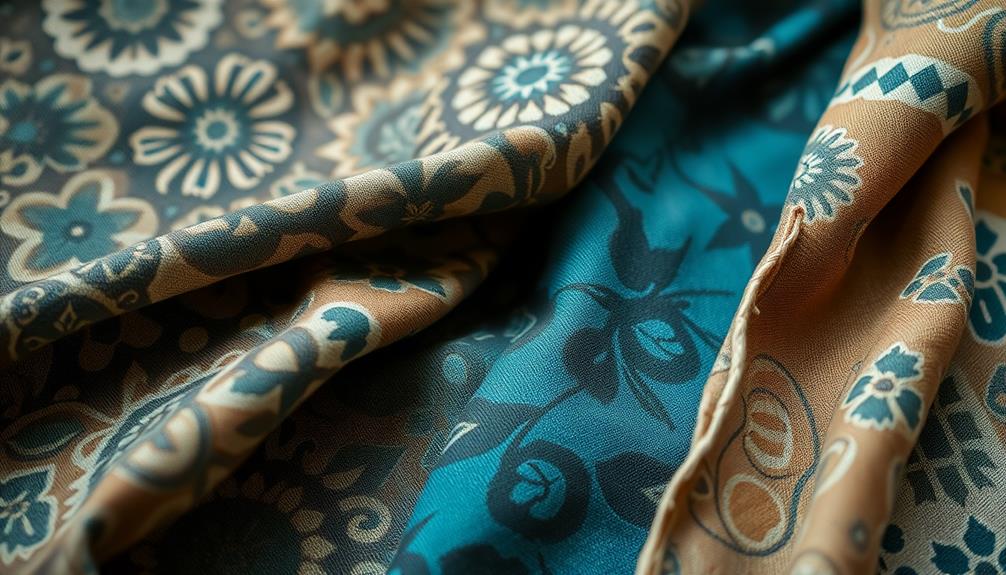
You mightn't realize that traditional batik techniques are at risk of disappearing due to modern production pressures.
The increasing urbanization and demand for faster fashion are pushing artisans to abandon time-honored methods in favor of quicker, less labor-intensive processes.
As cheaper printing methods take over, the intricate craftsmanship of hand-drawn batik is becoming less valued.
This shift not only threatens the artisans but also dilutes the cultural significance of this beautiful art form, reflecting the broader challenges faced in preserving traditional Indonesian housing.
Endangered Traditional Techniques
Often, traditional batik faces significant challenges that threaten its survival. As a UNESCO-recognized Masterpiece of the Oral and Intangible Heritage of Humanity, it deserves better than to be overshadowed by modern, cost-effective printing methods. The appreciation for traditional artistry, such as Balinese design characteristics, is essential in understanding the value of handcrafted textiles.
Here are some pressing issues you should be aware of:
- Erosion of Craftsmanship: The intricate techniques of hand-drawing and stamping are time-consuming and skill-intensive, often taking a full day to create a single piece.
- Dilution of Cultural Significance: Many contemporary prints marketed as batik lack the authenticity and craftsmanship that define the art form, stripping it of its rich heritage.
- Shifting Consumer Preferences: A growing demand for quicker and cheaper fashion options threatens the livelihoods of traditional batik artisans.
- Risk of Obsolescence: If awareness isn't raised about the complexities involved in traditional batik making, this cherished craftsmanship could become a lost art.
These challenges not only jeopardize the future of traditional batik but also the cultural identity it represents. Supporting artisans and their timeless techniques is vital for preserving this invaluable heritage.
Modern Production Pressures
The pressures of modern production are reshaping the landscape of traditional batik, posing significant challenges to its survival. As you explore the world of batik, you'll notice a troubling trend: many prints are now mass-produced, sacrificing the intricate craftsmanship that makes traditional batik unique. This shift to cost-effective printing methods threatens the labor-intensive hand-drawn techniques that can take an entire day to complete.
Moreover, the growing popularity of luxury tropical designs can overshadow traditional crafts, pushing artisans to adapt or abandon their heritage in favor of modern trends.
Today's consumers often overlook the time and skill involved in creating each piece of traditional batik, leading to a dilution of its cultural significance. With the allure of faster production and higher profits, younger generations might shy away from learning these painstaking techniques. This trend raises concerns among designers and artisans about the future of traditional batik craftsmanship.
To preserve this endangered art form, we need to raise awareness about the meticulous process of batik making and its cultural roots. By valuing the time and effort that goes into each piece, we can help promote the survival of traditional batik in a world increasingly dominated by modern production pressures.
It's crucial to recognize and support the artisans who dedicate their lives to preserving this heritage.
Modern Interpretations and Trends
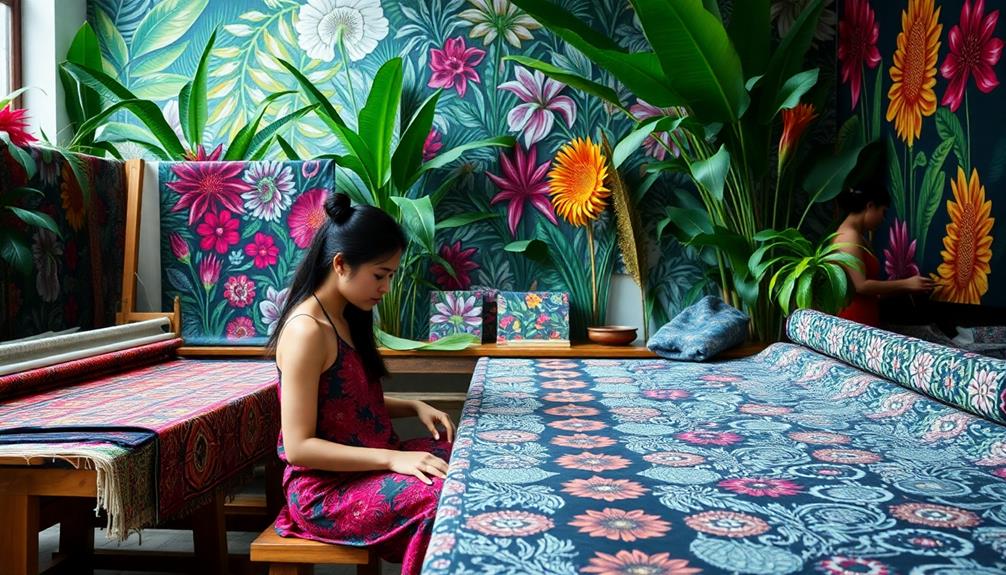
Many contemporary designers are redefining the use of traditional Indonesian textiles, particularly batik, to resonate with today's fashion landscape.
These modern interpretations bridge the gap between heritage and contemporary style, breathing new life into classic designs. The incorporation of luxury tropical design aesthetics can also be seen in how these textiles are utilized within modern interiors, enhancing the overall ambiance with their rich cultural narratives.
- Upcycled fabrics are gaining traction, as demonstrated by Lisa King's 30-piece collection, aimed at attracting a contemporary menswear audience.
- Indonesian designers like Chitra Subyakto are updating kebayas and batik textiles to engage younger generations, ensuring cultural preservation.
- The rise of batik in luxury fashion often strips away traditional artistry, sparking debate about the authenticity of mass-produced items.
- Social media has become a powerful platform for influencers, showcasing batik in diverse styles and driving its popularity in modern fashion.
These trends reflect a dynamic evolution of batik, where traditional craftsmanship meets modern aesthetics.
By embracing these innovative approaches, you not only celebrate Indonesian textile heritage but also foster a deeper connection with the fabric of your culture in a contemporary context.
As you explore these modern interpretations, consider how they can enrich your wardrobe or living spaces.
Future of Indonesian Textiles
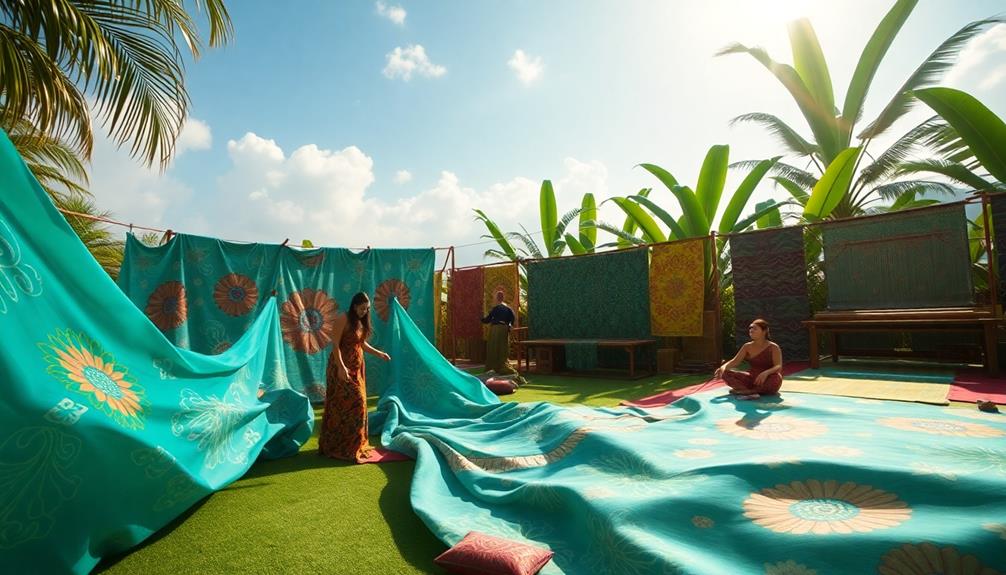
As you look ahead, the future of Indonesian textiles, especially batik, hinges on preserving traditional craftsmanship amidst the rise of modern printing methods. Many artisans face challenges, but with commitment and collaboration, there's hope. Designers like Chitra Subyakto are key to this revitalization, blending traditional techniques with contemporary aesthetics to engage younger audiences.
The increasing emphasis on sustainability in fashion is another crucial aspect. By adopting eco-friendly practices and utilizing sustainable materials, the Indonesian textile industry can thrive while respecting its roots. Here's a look at the future landscape:
| Aspect | Current Trends | Future Directions |
|---|---|---|
| Craftsmanship | Traditional techniques fading | Revitalization through education |
| Sustainability | Rise in eco-friendly practices | Increased use of natural dyes |
| Cultural Relevance | Limited appeal to younger crowd | Modern adaptations by designers |
Frequently Asked Questions
What Is the Indonesian Textile Technique?
The Indonesian textile technique primarily involves batik, where you apply hot wax to fabric, creating intricate patterns before dyeing. Additionally, ikat features tie-dyeing threads before weaving, resulting in vibrant designs celebrated across various regions.
What Is the Famous Fabric Design of Indonesia?
When you think of Indonesia, batik instantly comes to mind. This exquisite fabric features intricate, meaningful patterns, showcasing the rich Javanese culture. Hand-drawn batik, especially, reveals the artistry and dedication behind each unique piece.
What Are the Two Main Materials Used to Make Indonesian Batik?
When you explore Indonesian batik, you'll find that cotton and silk are the two main materials used. Cotton's affordability and versatility pair beautifully with silk's luxurious quality, enhancing the vibrancy of the intricate designs.
What Is Batik Fabric Used For?
Did you know that over 80% of Indonesians wear batik at least once a month? You'll find batik fabric used for clothing, interior design, and ceremonial attire, showcasing its versatility and cultural significance in everyday life.
Conclusion
In exploring the rich tapestry of Indonesian textiles, you uncover not just fabric, but a living history woven with cultural significance and sustainable practices. As designers innovate, they carry the torch of tradition into the future, ensuring that the vibrant stories of batik endure. Embrace these secrets, for every thread tells a tale of resilience and artistry, reminding us that just like fabric, culture is stitched together, stronger and more beautiful with each passing generation.

